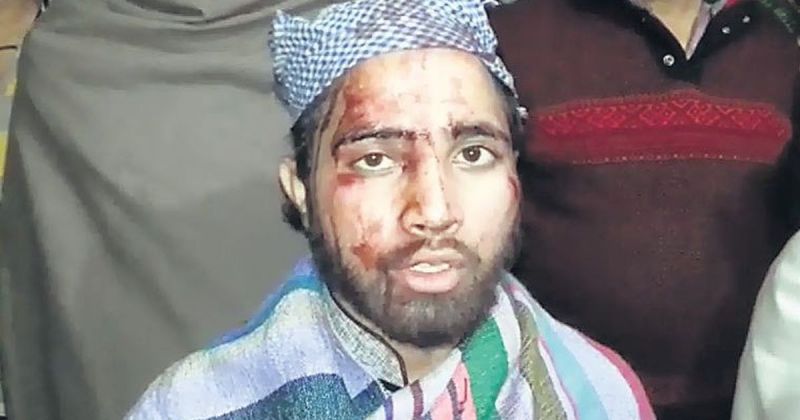Shoaib Daniyal,
On Wednesday, a Muslim cleric and his two relative were assaulted and stabbed on a train in western Uttar Pradesh. This was a hate crime – the victims were picked out for their religion. Mohammad Israr, one of the victims who had received stab wounds from an ice pick on his back, head and hands said that their Muslim appearance – with namaaz caps and scarves – had irked the attackers. While the men were being assaulted, the attackers said repeatedly, “You wear caps? We will teach you to wear caps.”
This is not the only incident of Muslims in Uttar Pradesh becoming the focus because of their clothing. On November 21, a Muslim woman was instructed to remove her burqa by the police in a rally by Uttar Pradesh chief minister Adityanath. A couple of days after this, the Bharatiya Janata Party made a formal demand to the Election Commission of India, asking for special verification of voters in burqas. “Women sporting the veil should be verified if needed,” the BJP said. “For this women security personnel or women election officers should be deployed at booths.”
From these incidents, it would almost seem that there is an attempt to erase from public view the typical dress of North Indian Muslims – kurta-pyjama and caps for men, burquas for women. It’s as if Hindutva forces want to create a public sphere that, if not literally devoid of Muslims, is certainly devoid of Muslimness.
Hindutva rising
The issue of looking Muslim is not a new one or, for that matter, only confined to Uttar Pradesh. In 2015, for example, a Muslim man’s beard was pulled even as he was assaulted and robbed on a train in western Uttar Pradesh. Like the namaaz cap and kurta, the beard is also a prominent symbol of Muslimness.
In 2014, a Muslim man Mohsin Shaikh was lynched in Pune by around 25 members of a group called the Hindu Rashtra Sena. The members of the Hindu Rashtra Sena were angry about morphed images they had seen circulating on social media. When they stepped out, they spotted Shaikh, who had a beard and was wearing a green Pathan suit, slotting him as Muslim.
In June this year, a 15-year old boy named Junaid was singled out as Muslim for the cap he was wearing and stabbed to death in a train in Haryana. In Junaid’s village, in Faridabad, a district in Haryana that borders Uttar Pradesh, men are trying to look “less Muslim”, dropping obvious articles of clothing such as namaaz caps or shaving off their beard. The Telegraph found that symbols of Muslimness are now found less visible on the train route on which Junaid was murdered. Muslims think it too risky to wear their namaaz caps while commuting.
Airbrushing reality
In his 2004 essay “On representing the Musalman”, historian Shahid Amin deftly critiques the Nehruvian “Unity in diversity” dictum that represented Muslims – and other minorities – using blunt stereotypes. In government “unity in diversity” posters, Muslims are represented by a man wearing a fez cap.
Thirteen years after this essay, things have moved from bad to worse. Earlier, Muslims were stereotyped, yet – small mercies – they were still part of government propaganda. Yet, now, with Hindutva rising, there is pressure for Muslims to remove markers that are visually distinct.
This trend is particularly acute in Uttar Pradesh. Looking Muslim has resulted in a range of penalties, ranging from chastisement by the police to outright assault. This behaviour is backed up by the administration, led by a chief minister who is not only accused of communal rioting but has gone on record claiming that secularism – a constitutional principle – is a lie.
Two Nation theory
This airbrushing of Muslims from the public sphere is not unexpected. Vinayak Savarkar, the man who coined the word “Hindutva” was a firm believer in the Two-Nation Theory and postulated that in India, Muslims must subordinate themselves to Hindus.
The expectation that Muslims should be made politically irrelevant in India finds deep resonance with the BJP charge of “vote banks”, the notion that minority communities are pandered to by politians for electoral gain. But the fact of Indians voting as groups is a banal reality: voting along caste, geographical or gender lines is a common way for groups to pressure leaders to act. Patels in Gujarat might vote for reservations or a village for a new tubewell. None of this attracts censure – till the group in question happens to be members of minority communities.
Vote banks
As a result, the BJP rarely courts Muslims, preferring to rely solely on Hindu votes. In the March landslide in the Uttar Pradesh Assembly elections, for example, the BJP stitched together a remarkable multi-caste Hindu alliance, winning 40% of the vote.
Even when the BJP desires Muslim votes, its methods don’t rely on the quid pro quo that characterises India’s transactional democracy. For example, in one recent case, civic polls in Uttar Pradesh saw a BJP leader threaten Muslims to vote for the BJP. Even while asking for their votes, the BJP does not see Muslims as legitimate players in the political space. While other voters could ask for, say, roads or water works, in return for their ballots, Muslims in Uttar Pradesh are not worthy of even such a transaction.
So successful has the BJP’s pitch been on this score than even some Muslim leaders now agree that it would be better if Muslims strategically excused themselves from the political space given that it would “polarise society”.
Courtesy: Scroll.in

